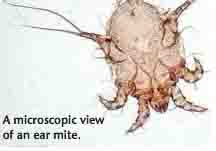Care and Treatment of a
Labrador Ear Infection
A Labrador ear infection can be caused by a variety of things including ear mites, allergies and even, in some cases, hereditary factors.
Often the cause can be bacterial in which case it is easily treated with antibiotics but when a Labrador ear infection is the result of other causes than treatment isn't always so straight forward.
Ear Infections (Otitis Externa) & Ear Cleaning in Dogs
"My dog's ears have a terrible odor. What could it be?" "My puppy has been scratching his ears. The ears have dark, crumbly material in them. What should I do?" "My dog has been rubbing his ears on the carpet, but I do not see anything wrong. Why is he doing this?" These are some of the most commonly asked questions of veterinarians."
Signs of Ear Disease
Every day we see dogs who have problems with their ears. Signs of these ear problems include:
- Odor
- Scratching or rubbing of ears and head
- Discharge in the ears
- Redness or swelling of the ear flap or canal
- Shaking of the head or tilting it to one side
- Pain around the ears
- Changes in behavior such as depression or irritability
Ear disease is one of the most common conditions we see in pets. The medical name for inflammation of the outer ear canal is 'otitis externa.' It is estimated that up to 20% of the dog population is affected by this disease.

Causes of Labrador Ear Infection
Dogs can have ear problems for many different reasons. When we see a dog with ear disease we need to think about the possibility of:
- Allergies such as atopy or food allergies
- Parasites - ear mites
- Microorganisms - bacteria and yeast
- Foreign bodies, e.g., plant awns
- Trauma
- Hormonal abnormalities, e.g., hypothyroidism
- The ear environment, e.g., excess moisture and ear anatomy
- Hereditary or immune conditions, and tumors
Allergies and Labrador Ear Infection
Dogs with allergies, either to food or something they inhale, often have ear problems. As a matter of fact, the ear problem may be the first sign of the allergy. Since the allergy changes the environment within the ear, we sometimes see secondary infections with bacteria or yeast. If we just treat the infection, we are not getting to the root of the problem. We need to treat the allergies too.
Dog Ear Parasites

The ear mite, Otodectes cynotis, is a common cause of ear problems in cats, but less common in dogs. Some dogs are hypersensitive to the mites, however, and the resultant itching can be intense. These dogs may scratch so much they severely traumatize the ear.
Dog Ear Bacteria and Yeast
Numerous types of bacteria and the yeast, Malassezia pachydermatis, cause ear infections. The normal, healthy ear has a good defense against these organisms, but if the ear environment changes due to allergies, hormone abnormalities, or moisture, the bacteria and yeast can greatly multiply and break down these defenses.
Foreign Bodies
Plant awns, those little "stick-tights" that cling to our clothes and
our dogs' fur, can sometimes enter the ear canal. Their presence causes
irritation, the dog scratches, and before you know it we have a
traumatized, infected ear So when you groom your dog after a walk in the
woods, be sure to check the ears, too.
Grass blades can also become lodged in the ear, allowing moisture to build-up, resulting yeast and bacterial infections.
Dog Ear Trauma
As we described above, self-inflicted trauma to the ear due to scratching can exacerbate ear problems.
Hormonal Abnormalities
Deficiencies or excesses of various hormones can result in skin and ear problems. Thyroid hormone, glucocorticoids produced by the adrenal gland, and sex hormones all influence the health of the skin and ears.
Ear Environment
Bacteria and yeast could not ask for a better environment to live in than a warm, dark, moist ear canal. Dogs with heavy, floppy ears such as Cocker Spaniels may have ear problems due to the excess moisture that builds up in their ears.
Other Causes of Canine Ear Problems
There are various rare hereditary diseases that occur in different breeds or lines and affect the ears. These include dermatomyositis in Collies and Shetland Sheepdogs, and primary seborrhea in Shar Peis and West Highland White Terriers. Squamous cell carcinomas, melanomas, and other tumors can be seen in the ears.
Dog Ear Problem Diagnosis
Because there are many potential causes of a Labrador ear infection or ear problems, we cannot just say it is a bacterial infection, dispense antibiotics, and it will go away. Often, more work is needed. Your veterinarian can use an otoscope to look down into the ear canal and determine the amount of inflammation present, if the tympanic membrane (ear drum) is involved, and if there are any foreign bodies, tumors, or other potential causes of the problem. Swabs of the ear can be taken, smeared on a microscope slide, stained, and examined for bacteria, yeast, and mites. A thorough history and physical exam may help determine if this could be a hormonal, allergic, or hereditary problem. If these are suspected, further diagnostic testing would be needed. If a bacterial infection does not respond to the first antibiotic therapy, a culture and sensitivity may need to be performed to select a different antibiotic.
Canine Ear Problem Treatment
The treatment is going to depend on what caused the Labrador ear infection or ear problem and what secondary conditions are there as a result. Antibiotics are used for bacterial infections and antifungals for yeast infections. Glucocorticoids such as dexamethasone are often included in these preparations to reduce the amount of inflammation in the ear. Ear problems caused by a systemic disease such as a hormone abnormality or allergy must include a therapy that treats the whole dog, such as hormonal replacement or allergy testing and hyposensitization (immunotherapy).
Allergies
Allergies are commonly treated with regular ear cleaning with an ear cleaning solution, antihistamines, and fatty acid supplements. Sometimes corticosteroids are needed. These may be given in an oral or injectable form, or they can be applied topically. Allergy testing and immunotherapy (hyposensitzation) may be the best way to cure the ear problem.
Ear Mites
Ear mites can cause a dry, dark, crumbly debris in the ear that resembles coffee grounds. For this condition, ear cleaning followed by an ear medication to kill mites will eliminate the problem, although the treatment may need to be continued over several weeks depending upon the product used.
Dog Ear Yeast
Yeast can cause severe ear problems. We usually observe a brown waxy exudate and a bad odor. Daily cleaning of the ears will help, but often these infections are difficult to treat, and special medications need to be given since antibiotics do not kill yeast. If you suspect a yeast infection in your dog’s ears, consult your veterinarian.
Dog Bacterial Labrador Ear Infections
Bacterial infections can also have a bad odor and often have a more yellowish exudate. If it is a severe or chronic condition, ear cleaning alone will not take care of the problem and antibiotics will almost always be necessary. Again, consult your veterinarian. Ear infections of the canal, if severe, can spread to the middle and inner ear, so prompt attention to the problem is always best.
Regardless of the cause of the Labrador ear infection or disease, we must always keep the ear canal clean.
Dog Ear Disease Prevention
The key to healthy ears is to keep them clean. Check your dog’s ears weekly. A slight amount of waxy buildup may be present in normal ears. If your dog swims a lot, has pendulous ears, or a history of ear disease, routine cleaning (often once to three times per week) is recommended. Use the same procedure as described above. Excess hair around the ear can be clipped to allow more air flow. Treat any underlying condition that predisposes your dog to ear problems.
If a dog is prone to ear infection, a natural product that helps maintain the ear's natural fora protective balance such as Ear Dr. is worth a try.
Remember, if your dog is showing severe discomfort, the ears have a bad smell, or the ear canals look very abnormal, do not delay in contacting your veterinarian so that he or she can check for a Labrador ear infection. If your dog has a ruptured or weakened eardrum, some ear cleansers and medications could do more harm than good.
Reprinted as a courtesy and with permission from PetEducation.com
Dog Ear Cleaning
Your dog’s ear is more L-shaped than yours, and debris loves to collect at the corner of the L. To remove this debris, fill your dog’s ear canal with a good ear cleaner. Ear cleaners should be slightly acidic but should NOT sting. Massage the base of the ear for 20-30 seconds to soften and release the debris. Wipe out the loose debris and excess fluid with a cotton ball. Repeat this procedure until you see no more debris. Depending on your dog’s ear condition, you may have to start out doing this twice a day.
Cotton applicator swabs can be used to clean the inside of the earflap and the part of the ear canal you can see. They should NOT be used farther down in the ear canal since that tends to pack debris in the ear canal, rather than removing it.
Some ear problems are so painful, the dog must be anesthetized to do a good job of cleaning the ears. You may find your dog does not like to have his ears cleaned because it is uncomfortable. Talking to him during the process, stopping momentarily to give him a treat if he is doing well (we do not want to reward fussiness!) and doing something fun afterwards may all help.
After the ear is clean, let the dog shake his head and allow some time for the ears to dry. Then you can apply any ear medication that was prescribed.
Have A Labrador Retriever Ear Health Question for our Veterinarian?
Do you have a Labrador Retriever ear related question for our Vet? We'll answer it for FREE! Just fill out this form and our Vet will get back to you as soon as possible.
Please include information such as the sex, medical history, medications, changes in behavior, when symptoms first appeared and anything else you believe would be helpful. Please send a picture to help us understand the ear problem.
Questions are answered on a first come, first served basis and may take some time depending on the number we receive. If you have an urgent question, we suggest using this low cost online veterinary question service that has Vets standing by 24 hours a day, 7 days a week to help.
What Other Visitors Have Asked our Vet and Related Answers about Dog Ear Problems
Click below to see contributions from other visitors to this page...
Dog Ear Infection Treatment Advice 




Reader Question on Chronic Dog Ear Infection Treatment
Hello,
My name is Irene, I live in the mountains of Peru, with my family and two labrador …
Treating Regular Labrador Ear Irritation Not rated yet
Reader Question: How to treat dog ear irritation?
My 6 year old lab has a regular ear irritation, he has been allergy tested but came back with really …
Vinegar and Water to Prevent Chronic Dog Ear Infection Not rated yet
My Black Lab swims a lot and continually gets ear infections.I have been told that putting a mixture of vinegar and water at 50/50 mixture after swimming …
Articles Related to Labrador Ear Infection
Labrador Retriever health
Labrador Dental Health
Lymphoma In Labradors
Return To The Top Of This Labrador Ear Infection Page